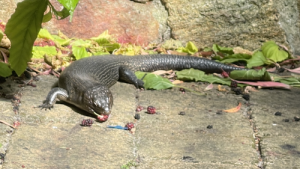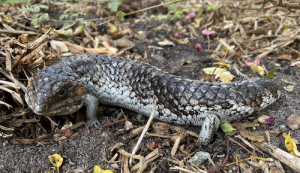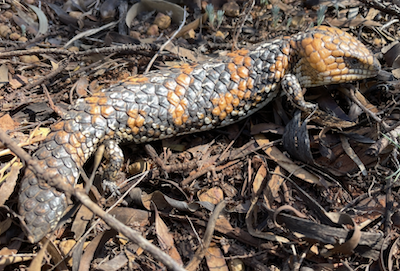
Skink Lizard
(“Yum, a delicious mulberry”)
Skinks are common in our garden, but they are not as attractive as Bobtails (aka Shinglebacks or Bluetongue lizards). Since the skink, who lives under the house, made an appearance during my meditation time, he is included here. I find it difficult to name reptiles as friends, but I do like Bobtails. It is probably because my brothers and I made it a habit, on our childhood farm, to capture local wildlife and keep them as pets. Turtles, wild ducks, bobtails & other lizards and gilgies (a local small freshwater crustacean) were included in our menagerie. Their captivity usually only lasted a few days before the animals easily escaped. When we were children we were always pleased to see a bobtail because, according to my father, “When bobtails are around, snakes aren’t”. As an adult I suspect he wasn’t right. But he was right in another piece of his advice on bobtails, “Don’t let them bite you – they don’t let go.”
Bobtails, according to local Noongars, are tasty, particularly their tails in which they store fat for the lean times. On the other hand you have to be pretty hungry, they say, to eat a skink. Unfortunately, bobtails too commit car suicide and, because they are much slower than bandicoots, they seem to quickly come to a tragic end in an urban environment.
The only negative aspect to having skinks and bobtails in a garden is that they luuuv strawberries and will eat them just before the fruit are ready for me to pick and eat. The photo shows a skink gobbling up a mulberry.
Bobtails adapt their colours to the environment and are very well camouflaged. Notice the orange soil colour on the desert bobtail above and the garden brown on the garden bobtail. They are very tricky to see in the garden and often make one think ‘snake’ and step back with great urgency. They greet intruders with an open mouth, a vivid blue/black tongue and deep throaty ‘hiss’. In the strawberry patch or just along a path, bobtails present a fearsome sight when they hiss and stick out their blue tongue our to the blue.
Unusually for reptiles, bobtails hatch their eggs internally and nurture their hatchlings in a primitive placenta before giving birth to live young. The ‘birth’ ends parental responsibility for the lizard hatchlings! Once born baby bobtails are on their own. I am pleased to share my prayer space with Bobtails and Skinks. What message do blue tongue lizards bring to prayer garden?

Bob Tailed Lizard
(In our garden)
My Blue Tongue (James 3:3-12)
Why is the blue tongue lizard’s tongue blue?
Was he punished because he cursed his neighbour?
Did he hold his tongue too long and remain silent when he should have spoken?
Is he sending a message, “Don’t mess with me, I’ve got a blue tongue”?
Makes me think of my tongue:
…….I know my tongue both sings praises and pronounces curses
…….I know I say things I shouldn’t and don’t say things I should
…….I know my words have steered my ship into some rocky shoals
…….And I have inadvertently (or vertandly) started some fierce fires
…….I know I that out of the well of my mouth has come brackish water
…….Instead of life sustaining fresh water for others,
Maybe next time I look in a mirror my tongue will be blue too.
It’s ok, I checked, my tongue is not yet blue…
Thanks my shingleback friend and teacher for reminding me to
Mind my tongue.
This course will be given live on May 11th. It will be interactive with contemplative garden practices and much laughter involved.


